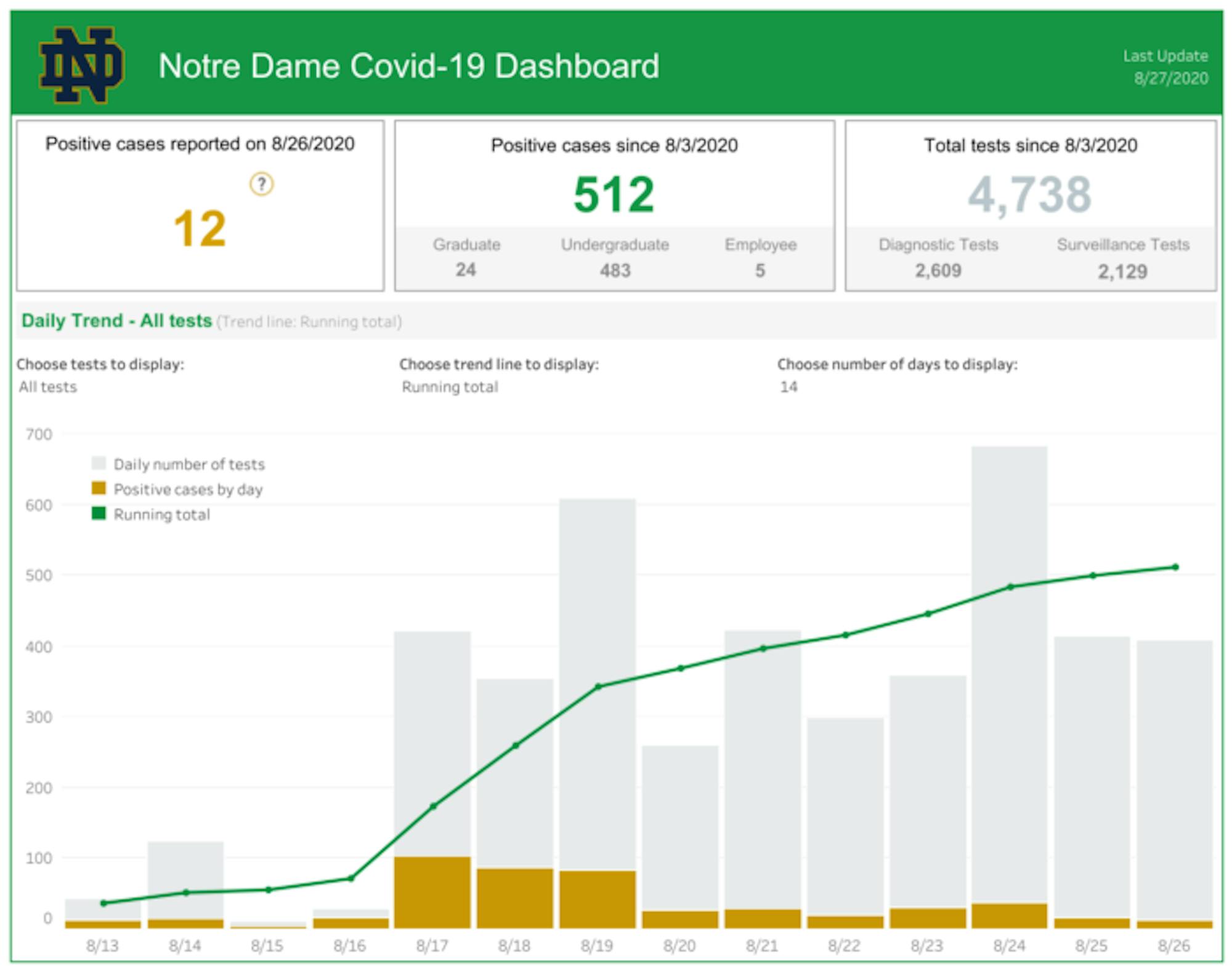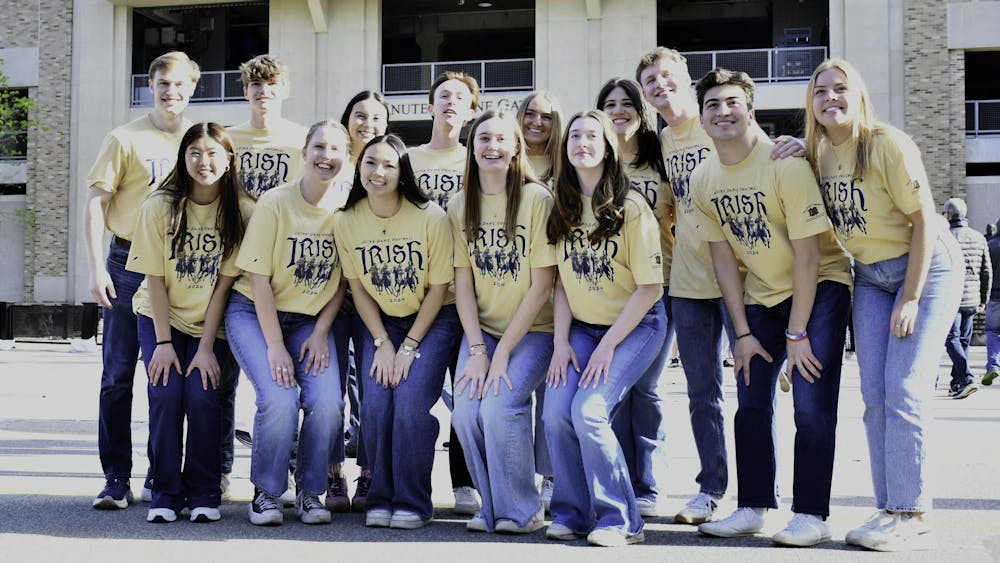The question of Notre Dame’s academic and social future remains the hot topic of the week — whether it be debated in Zoom classes, in passion in the dorms or over meals on the quad — especially as the 14-day campus pause nears its end. With a 512 COVID-19 case count as of Friday morning, a clear vision of the immediate future remains elusive to both students and Dr. Mark Fox, the St. Joseph County deputy health officer who has served as an advisor to the University regarding COVID-19 concerns since the spring. 
In an address to the Notre Dame community Aug. 18, University President Fr. John Jenkins said, “Upon receiving recent results, we began to make plans to try to send you home and continue instruction online as we did last spring, however, with the advice and encouragement of Dr. Mark Fox, we’ve decided to take steps short of sending students home.”
The day prior to the announcement, Aug. 17, yielded the largest number of positive test results in a single day yet this semester at 102 positive cases.
Fox said the cases seen in the early weeks of the semester, including this spike which occurred early last week, were largely linked to off campus activity.
“It gave me a little more hope that on-campus mitigation strategies were effective, and that’s important for considering continuing the semester in-person,” Fox said.
Fox contributed these thoughts to the conversation University officials had when considering whether or not to send students home.
“One of the challenges they faced early last week was the volume and the velocity of the cases that overwhelmed testing, that overwhelmed contact tracing and overwhelmed isolation and quarantine,” he said.
During the meetings, Fox said he advised classes to be moved online for at least two to four weeks, in order to “push pause, to try to interrupt the transmission.” In this way, Fox said, the transmission of the virus from off campus to on, and between those on campus could be slowed. The University could also then see if there is significant transmission of the virus on-campus, such as in dorms or in classes, and simultaneously accelerate testing, contact tracing and securing adequate isolation and quarantine space, he explained.
Since last Tuesday, Fox was pleased with how the University responded to the spike in cases, he said. He was also pleased with the improved access to testing, the installation of surveillance testing practices and the provision of additional resources to the contact tracing team.
“The plan didn’t fundamentally change,” he said. “It was really getting it up to scale.”
According to the HERE Dashboard, as of Friday morning 4,738 tests have been administered, and on Monday, 684 tests were conducted, the largest number in a single day to date.
Fox attributed this week’s flattening of the curve to the identification, testing and removal of those with the virus. In addition to their close contacts from others, which then limited further transmission and exposures. He also attributed the new data sets to the effects of remote learning and the limitation of interaction on campus. “It’s promising with a word of caution,” he said. “What I can follow of the surveillance data looks really encouraging actually.”
Fox said he was encouraged little evidence exists to suggest significant transmission has occurred in classrooms. He was also concerned students would return to earlier practices of partying and gathering unsafely as time progresses, and hoped students could continue following safety protocols.
Fox said he could not say when the University will decide or announce further course of action, whatever it may be.
“My hope all along has been the University community could aggressively pursue mitigation strategies,” he said. “My hope was that the University could actually be the microcosm that shows that if you do this [enact mitigation strategies], you can flatten the curve, and keep it flat and then resume something resembling a more normal academic, economic and social life.”
Isabel Snee, a junior in Lewis Hall, said Wednesday she was also optimistic after seeing the results on the dashboard this week.
“Now that the surveillance tests have started, as well as the ability to view the demographic of who tests positive, I feel more confident in ND’s ability to track the virus, as well as encouraged by the statistics gleaned from the new data models,” she said in an email.
A neuroscience and behavior major with a minor in data science, she said, “Let me be clear: all of the information on the Dashboard should be scrutinized and integrated together to determine the real threat of the virus on campus. But each metric must be weighed differently to accurately do so.”
Snee said she does not foresee the student body being sent home, but rather, at least another two weeks of remote learning and a gradual transition back to in-person classes.
“I do not believe the University should send students home,” Snee said. “However, I think students should have the option to attend virtual classes or leave campus if they feel uncomfortable/unsafe.”
Snee herself values in-person education, noting the difficulty to bond with peers and instructors remotely. However, “I am not entirely opposed to the virtual learning," she said. "I decided when I arrived that as long as I could stay on campus and near my friends, I would accept the possibility that virtual learning would eventually become the norm.”
Junior Gabrielle Huggins said she had been optimistic about the semester until last Tuesday.
“For the first time, I was extremely concerned and I was a bit angry, not at the University, but at my fellow students.” she said in an email.
As an off-campus student, Huggins said she witnessed many of her own peers flaunt regulations.
“I saw a pattern of ignorance being propagated around the idea of mask-wearing and social distancing, a luxury of privilege that many at this school and abroad do not have," she said. "Privilege to not have to think about an underlying condition, privilege to not have to worry about access to testing, privilege to ignore the effects of the virus on the lives of millions worldwide and domestically, but most of all privilege to not take into consideration the others in their immediate vicinity who are directly impacted by their actions.”
Huggins said she had prepared herself to see classes moved completely online after Fr. Jenkin's announcement. But since last Tuesday, she has been encouraged by the flattening of the curve.
“It is very encouraging and indicative, at least as of now, that we should be returning to in-person classes at the end of this two-week hiatus,” she said. “I applaud my fellow students for being able to have the awareness to prioritize the population of Notre Dame.”
Huggins, a biology and English major, concluded from her conversation with others, believes that classes will resume in person Sept. 2, though she remained skeptical.
“I think endangering individuals for the want of education is something that we should consider deeply before making these decisions of whether to stay or go,” she said. “Ultimately, I think the situation is very complex and there is never going to be total agreement, but it is much harder to learn in the climate of anxiety and fear that surrounds COVID."













